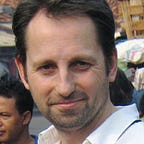The Road Beyond Covid
What happens after what happens next? My take on what the world might look like during and after vaccination, and why the challenge of Covid is one that tests our fundamental human instinct — movement
(This piece originally appeared on my blog)
I’ve tried to avoid predictions this year for obvious reasons, but I think we’re seeing signs of impending dawn on the new era. I won’t call it Post-Covid, because that’s supposing too much, but definitely there are the signs of a new infrastructure being built that will allow us to return to something like our previous existence. But I think there are still parts of it that we haven’t thought through.
For our society to function we need people to be able to move around relatively freely. It doesn’t matter if it’s a businessman flying off to check out a subcontractor, food being trucked from Porto-Novo to Niamey, or me meeting one of my clients in the CBD. The modern world doesn’t function without movement. Covid has made that hard because it highlights the contradiction between our lifestyle and our biology, which appears to be geared to small, self-contained groups — villages, or tribes, if you will — which may move around but do not come into contact with other groups. The first recorded pestilence, for example, is believed to have been when the Philistines usurped the Arc of the Covenant and moved it from place…
